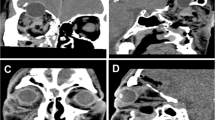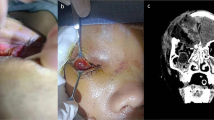Abstract
Background
The mechanism of complete dislocation of an intact globe into the maxillary sinus after an extensive blowout fracture has not been clearly documented.
Methods
A 68-year-old man sustained orbital wall fractures of the right orbit, resulting in dislocation of the globe into the maxillary sinus, associated with the transection of the medial and inferior rectus (MR and IR). We repaired the orbital wall fractures using Medpor barrier sheets, and repositioned the dislocated globe. And then, the distal section of the IR was sutured at its proximal end and the severed distal section of the MR was sutured at the fascial sheath and Tenon’s capsule.
Results
After repositioning, the eyeball was intact without signs of perforation, but the patient’s visual acuity was impaired, exhibiting a loss of light perception, coupled with a noted pallor of the optic disc. The patient’s eye movement was severely restricted, but supraduction and abduction proved possible.
Conclusions
This case demonstrates that the globe can be dislocated into the maxillary sinus following orbital wall fracture associated with extraocular muscle injury, and provides a clue into the mechanism underlying dislocation of the globe into the maxillary sinus.



Similar content being viewed by others
References
Berkowitz RA, Putterman AM, Patel AB (1981) Prolapse of the globe into the maxillary sinus after orbital floor fracture. Am J Ophthalmol 91:253–257
Flower JG (1941) Spontaneous luxation of the eyeballs. JAMA 116:1206–1208
Manson PN, Clifford CM, Iliff NT et al (1986) Mechanisms of global support and posttraumatic enophthalmos. Adv Plast Reconstr Surg 77:193–202
Noorden GK, Campos EC (2002) Binocular vision and ocular motility, 6th edn. Mosby, St. Louis
Pelton RW, Rainey AM, Lee AG (1998) Traumatic subluxation of the globe into the maxillary sinus. Am J Neuroradiol 19:1450–1451
Wilder I, Beyer C, Smith R et al (1971) Ocular findings following radical maxillectomy. Trans Am Acad Ophthalmol Otolaryngol 75:797
Ziccardi VB, Patterson GT, Ramasastry S et al (1993) Management of severe zygomatico-orbital fracture with dislocation of the globe into the antrum. J Craniofac Surg 4:95–101
Author information
Authors and Affiliations
Corresponding author
Rights and permissions
About this article
Cite this article
Kim, S., Baek, S. Traumatic dislocation of the globe into the maxillary sinus associated with extraocular muscle injury. Graefe's Arch Clin Exp Ophthalmo 243, 1280–1283 (2005). https://doi.org/10.1007/s00417-004-1111-8
Received:
Revised:
Accepted:
Published:
Issue Date:
DOI: https://doi.org/10.1007/s00417-004-1111-8




